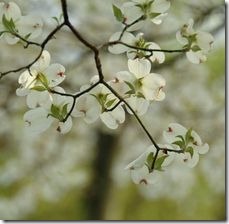Flowering dogwoods (Cornus florida) produce white flower blossoms in the spring and brilliant red foliage in the fall. These trees are great landscape elements and attract a lot of wild life for the food they provide with their seeds and fruit, bark, twigs and leaves. This high maintenance tree, however, requires prudent planting and care in order to enjoy the spring blossoms.
Attaining Flowering Dogwoods
-
Do not transplant wild flowering dogwood trees. You run the risk of planting a pest infested or disease ridden dogwood. Instead, purchase flowering dogwood saplings from well-known garden centers or nurseries with certified disease-free dogwoods. Check to be sure the ball of the tree is moist with sufficient soil surrounding the roots. The sapling should be free of damage or lesions, otherwise you may end up with a pest problem.
Soil
-
Dogwoods require nutrient dense soil in order to produce healthy flowering. Soil quality determines dogwoods access to water, nutrients and efficiency in utilizing these nutrients. Lack of nutrients will cause the dogwoods not to flower. Consider adding mycorrhizai fungai to the soil to increase flowering.
Planting
-
Thriving dogwoods require moist, shady areas with nutrient rich soil. As is the case with planting most other trees, the planting hole should be three times the diameter of the root ball, with only the top of the root ball level with the ground surface. Cover the root ball with the original soil and maybe some organic material. Unless nutrient deprived, fertilizer is not necessary for the soil. Apply mulch on top of the soil to help lock in moisture and prevent weeds.
Care
-
Supplemental watering should be done during weekly dry periods. Unless there are injured or dead branches, pruning is generally not necessary. Because dogwood bark damages easily, extra care is needed when mowing or using any garden tools around them. Injuries not only weaken dogwoods, but bring an onset of unwanted insects and fungus to the damaged bark.
Disease
-
Discula destructiva fungus causes dogwood anthracnose disease, which is very lethal to dogwoods. Light brown spots form on the leaves, eventually growing into larger splotches (which may be surrounded by purple) and moving to the twigs, main limbs and trunk. Any large cankers that develop as a result typically kill dogwoods. Property owners with ailing dogwoods should consult with tree specialists. Dogwoods positively verified with dogwood anthracnose are administered fungicides to kill the infection. Removal and disposal of the leaves surrounding dogwoods will reduce the possibility of infection.


Deprecated: strpos(): Passing null to parameter #1 ($haystack) of type string is deprecated in /home/agriviek8Qv/agriviet.net/public_html/wp-includes/comment-template.php on line 2522